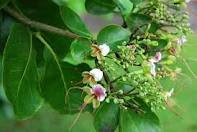This false teak tree is a member of the Fabaceae or Leguminoseae family, making it a relative of dhak, the pongam tree, ashoka (Saraca indica),the monkey pod tree, jhand, lentils, indigo, the butterfly pea, chickpeas, soya beans, the Indian Coral tree and lupins (to name but a few of its relatives). It has a native range which spreads from Tanzania Madagascar Asia and the Pacific islands, where it is much prized for its valuable timber.
This tree is known by a number of names including Afzelia bijuga, Albizia bijuga, Eperua decandro, Intsia amboilensis and Intsia retusa. It has a number of English names too, which includes that of Moluccan Ironwood, and it is known as Ipil in the Philippines
This tree is not widely cultivated and is listed as vulnerable in the IUCN Red List of Threatened Species. It naturally grows in coastal areas and lowland rainforests. It is used for coastal protection as it grows, typically to heights of between 23 and 82 feet, (although it can grow much higher) providing shade and protecting the soil from erosion; it is also a nitrogen fixer so can help make poor soil more fertile. It is a good living fence, and its timber has many uses as railway sleepers, house post beams, and it is used in boat building and bridge building, as well as to make smaller items such as walking sticks, carved items and canoes.
In Fiji
In traditional medicine systems a decoction of the bark, which contains tannin, is used as a remedy for diarrhoea and dysentery, and the fruit of the tree is a remedy for constipation. A decoction of the bark is used to cure dark urine which is caused by evil spells or spirits. It is also employed for rheumatism, chills and stiff, aching muscles and an infusion of it is given to a new mother after childbirth, perhaps to keep evil spirits away, this is a little unclear.
 The seeds are edible but only after careful preparation which entails them being steeped in water for three to four days and then thoroughly boiled. Oil from the seeds repels pests rather as does neem (Azadirachta indica) so it can be used in linen to stop moths and insects eating the cloth. The seed pod is pear-shaped and leathery, containing from 1 to 9 seeds.
The seeds are edible but only after careful preparation which entails them being steeped in water for three to four days and then thoroughly boiled. Oil from the seeds repels pests rather as does neem (Azadirachta indica) so it can be used in linen to stop moths and insects eating the cloth. The seed pod is pear-shaped and leathery, containing from 1 to 9 seeds. Sap from the inner bark of this false teak is squeezed into coconut water for asthma, and this sap or the juice from the fresh leaves is squeezed into salt water, for diabetes.
Few studies have been carried out on this tree’s medicinal properties as yet.






No comments:
Post a Comment